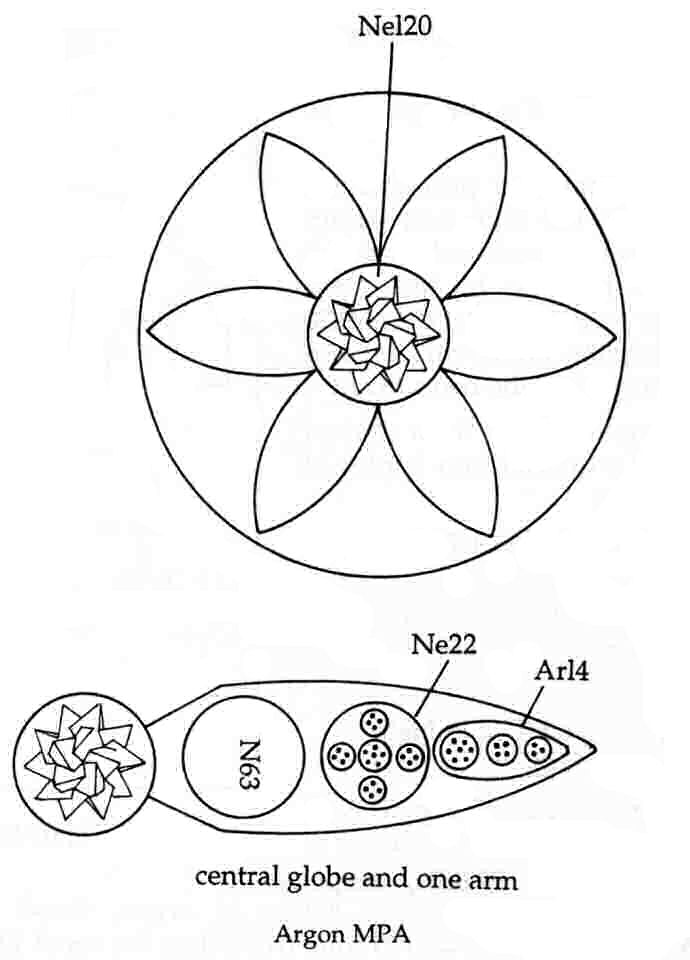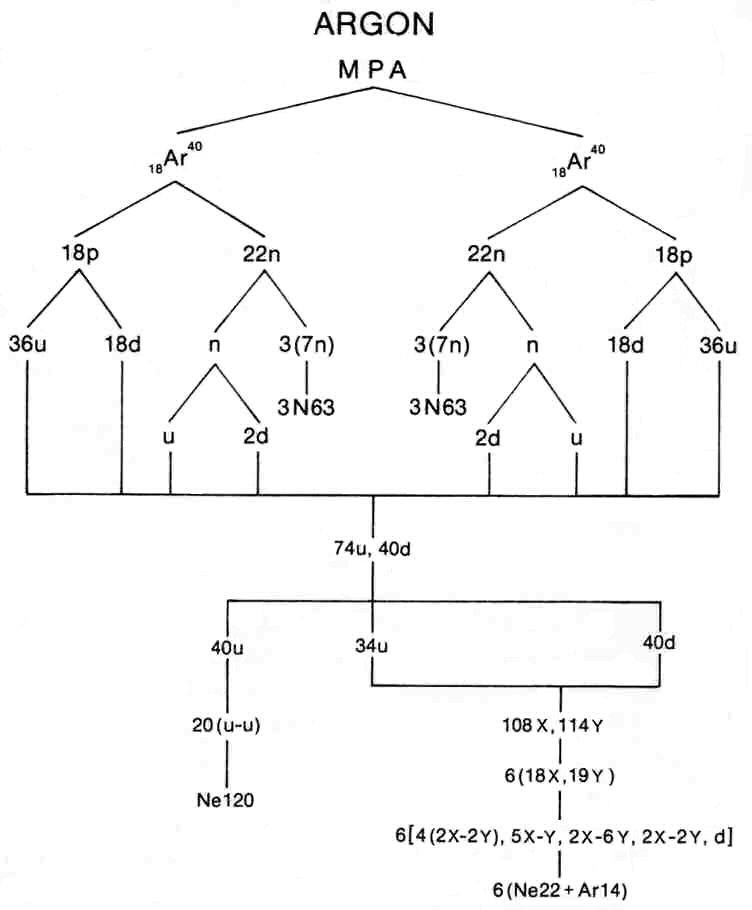
The Argon MPA

The argon MPA consists of a central globe containing the Ne120 group and six arms projecting from this centre towards the corners of an imaginary hexagon. Each arm is made up of an N63 group (see the nitrogen MPA), an Ne22 group (see the neon MPA) and, at its outer end, a group of fourteen UPAs (Ar14) that comprise a cluster of seven UPAs, a quartet of UPAs and a triplet of UPAs. Although it was published without a disintegration diagram, it can still be compared with theory because its Ar14 consists of three simple groups of UPAs whose disintegrations have been described in many other MPAs analyzed here.
Argon MPA = Ne120 + 6(N63 + Ne22 + Ar14).
The argon MPA is formed from two Ar40 nuclei, this being the most abundant of the
isotopes of argon. They provide 720 subquarks — six more than the number of UPAs. Forty-two of the forty-four
neutrons originally belonging to these nuclei are present still as six clusters of seven groups of three hydrogen
 triplets, i.e., the N63 is a cluster of seven neutrons. The Ne120 group cannot be a bound state
of twenty u-d diquarks (as found in the case of neon) because the 128 X subquarks and ninety-four Y subquarks
making up the remaining fifty-four u quarks and twenty d quarks could not then be distributed equally among
the six arms, as one would expect. It cannot be a bound state of twenty d-d diquarks for a similar reason. It
can be only a bound state of twenty u-u diquarks, the 108 X subquarks and the 114 Y subquarks making up the
remaining thirty-four u quarks and forty d quarks being uniformly distributed among the six arms.
triplets, i.e., the N63 is a cluster of seven neutrons. The Ne120 group cannot be a bound state
of twenty u-d diquarks (as found in the case of neon) because the 128 X subquarks and ninety-four Y subquarks
making up the remaining fifty-four u quarks and twenty d quarks could not then be distributed equally among
the six arms, as one would expect. It cannot be a bound state of twenty d-d diquarks for a similar reason. It
can be only a bound state of twenty u-u diquarks, the 108 X subquarks and the 114 Y subquarks making up the
remaining thirty-four u quarks and forty d quarks being uniformly distributed among the six arms.
As was found for the neon MPA, the Ne22 group is a cluster of four bound states of two X subquarks and two Y subquarks surrounding a core made up of five X subquarks and one Y subquark. The extra subquark predicted to be in each arm is either in the group of six UPAs at the centre of the Ne22 or — less probably, because this group was a new one unique to this MPA and therefore unlikely to have been misobserved because it would have been examined in detail — in the Ar14 group. Assuming the more likely former possibility and noting that the cluster of seven UPAs in the Ar14 group, although not explicitly described, must be either the I7 (4X-3Y) or its mirror particle I7′ (3X-4Y) because a similarly depicted group is recorded in the so-called "proto-argon" MPA to be discussed shortly, the following compositions are possible for the Ar14 group:
4X-3Y + 4Y + d quark (extra Y subquark present in the centre of the Ne22);
4Y-3X + 4Y + d quark (extra X subquark present in the Ne22);
4Y-3X + 4Y + u quark (extra Y subquark present in the Ne22).
As no disintegration diagram was provided for argon (presumably because the only new group Ar14 was made up of groups recorded in many other MPAs), it is not possible to test these predictions, as well as the prediction that the Ne120 is made up of forty (+) hydrogen triplets, not twenty (+) and twenty (-) triplets, as recorded in the neon MPA.
Besant & Leadbeater recorded observation of two other species of argon that they called "proto-argon" and "meta-argon." The MPA of proto-argon differs from that of argon by the absence of a quartet and a triplet of UPAs in each of its six arms:
proto-argon MPA = Ne120 + 6(N63 + Ne22 + I7),
whilst the MPA of meta-argon differs from that of argon by having seven more UPAs in each arm, the Ar14 being replaced by the mNe15 group and a cone of six UPAs (mAr6):
meta-argon MPA = Ne120 + 6(N63 + Ne22 + mNe15 + mAr6).
There are three stable isotopes of argon: Ar36, Ar38 and Ar40, with respective relative terrestrial abundances of 0.337%, 0.063% and 99.60%. In principle, these could provide six different MPAs of argon, those formed from the combinations (Ar40+Ar40), (Ar40+Ar38) and (Ar40+Ar36) being the most likely to have been observed. Because meta-argon has a more populous MPA than proto-argon, one might expect the former to be formed from an Ar38 nucleus and an Ar40 nucleus and the latter to be formed from nuclei of Ar36 and Ar40. But the greater abundance of the Ar36 nuclide would then make proto-argon more likely to have been observed than meta-argon, whereas, according to Occult Chemistry: "It is extremely rare in the atmosphere."1 Identification of the appropriate nuclide cannot therefore be based solely on UPA populations, this conclusion being supported by the fact that the ordinary argon MPA, which is, supposedly, formed from the stable argon nuclide with the largest mass number, has fewer UPAs than meta-argon, even when its predicted six, unobserved UPAs are taken into consideration. The possible presence of errors of observation makes identification of the nuclides responsible for the three types of argon MPA an uncertain matter. The only combination of argon nuclides that makes the MPA of proto-argon both the least populous and the rarest of the three types of MPAs is (Ar36+Ar38). These nuclei contain 332 X subquarks and 334 Y subquarks. As a bound state of twenty identical diquarks, the Ne120 could consist of either sixty X subquarks and sixty Y subquarks (Ad6 = u-d), eighty X and forty Y subquarks (Ad6 = u-u) or forty X and eighty Y subquarks (Ad6 = d-d). The number of subquarks present in each arm would be:
| X | Y | |
| Ad6 = u-d: | 272 | 274 |
| Ad6 = u-u: | 252 | 294 |
| Ad6 = d-d: | 292 | 254 |
Only the numbers 252 and 294 are divisible exactly by 6, which means that the Ad6 groups in the Ne120 must be u-u diquarks, implying that there are forty-two X subquarks and forty-nine Y subquarks in each arm. Given that the N63 group consists of either seven neutrons (28X, 35Y) or seven protons (35X, 28Y), i.e., the mirror state N63′, and given that the Ne22 consists of either thirteen X subquarks and nine Y subquarks or — if it is the mirror state Ne22′ — nine X subquarks and thirteen Y subquarks, it is deduced that the N63 must consist of seven neutrons because seven protons, together with the Ne22 or Ne22′ group, require more X subquarks in each arm than are available. The I7 group should consist of six, not seven, UPAs (either one X subquark and five Y subquarks or — if an Ne22′ group is present — five X subquarks and one Y subquark). This prediction cannot be tested because no disintegration diagrams were provided for the argon MPAs.
If the meta-argon MPA is formed from two Ar40 nuclei, six too many UPAs were observed in each arm. It is implausible that the cone of six UPAs should never have been observed! More likely, UPAs are absent from the Ne22 and mNe15 groups. The point is that the small discrepancy between theory and observation is plausibly explained in terms of a few minor errors made by Besant & Leadbeater.
References
1. Occult Chemistry (3rd ed.), p. 253.